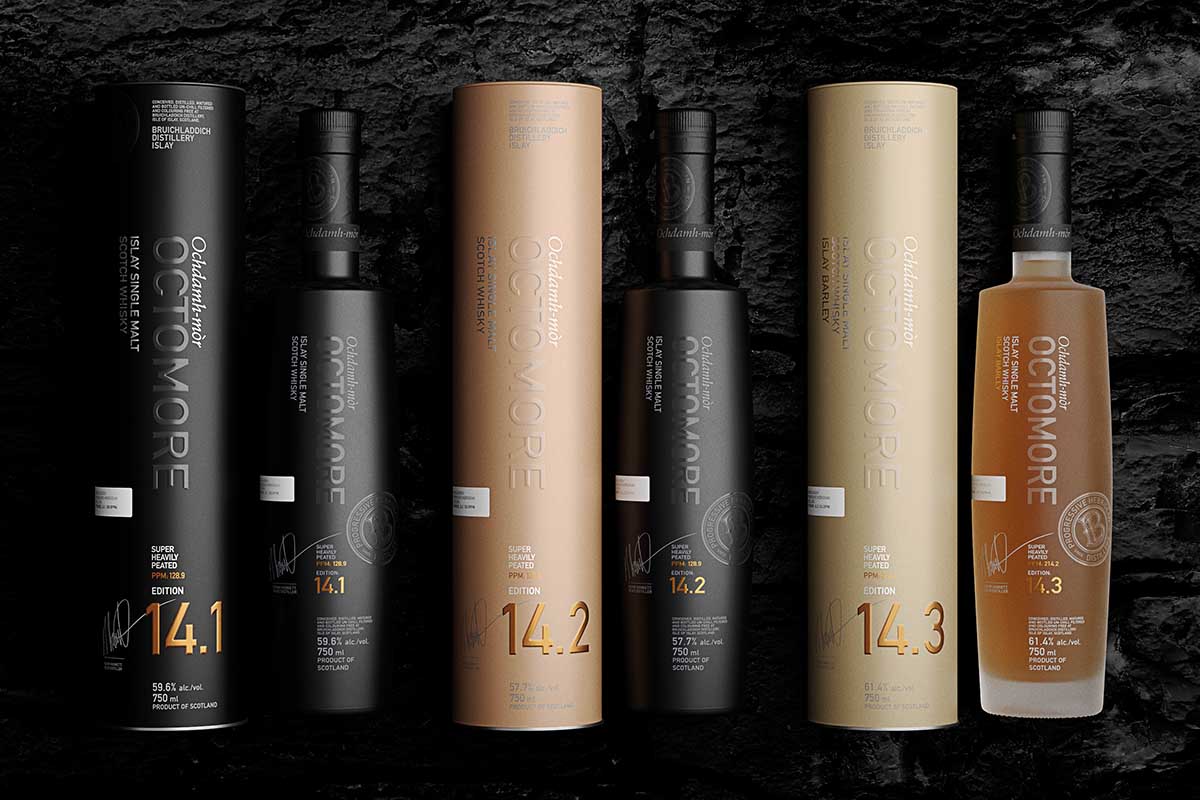What we’re drinking: Six new single malt releases from Bruichladdich, including the 14th editions of their peaty standout Octomore
Where they’re from: Revived in 2001, Bruichladdich is located on the southernmost end of western Scotland’s Hebridean Archipelago. The Islay distillery focuses heavily on local terroir; everything produced there is made with 100% Scottish barley and Islay spring water.
Why we’re drinking these: We usually say the annual release of Octomore is the best time of year for Scotch drinkers, particularly those who like their whisky extremely peaty.
This year’s a bit different. Don’t get me wrong: the new Octomore bottles (14.1, 14.2, 14.3) continue to refine the whisky’s initial mission, which was simply to be the world’s most heavily peated single malt.
Still, there’s an overall philosophy behind everything Bruichladdich releases, including their six new bottles, which run the gamut from unpeated to heavily peated to ridiculously peated. “It’s about transparency, it’s about provenance and it’s about really understanding the ingredients that we make whisky from,” says Head Distiller Adam Hannett.
The standout here is the Bere Barley 2013, which was aged primarily in first-fill American oak with some second-fill French oak. “When distilleries talk about whiskeys, they talk about age, casks and water sources, but they rarely focus on the main ingredient when making whiskey — the barley,” says Hannett. Here, Bruichladdich is using an ancient variety of barley, sourced from Orkney, that can be traced back 2,000 years. “It’s very different from modern strains of barley,” as Hannett notes.
Review: Why Octomore Remains the Most Interesting Scotch
The 13th annual release from Bruichladdich is still heavy on the peat but also deftly showcases the influences of cask finishes and local terroirAs for the others: Black Art is Bruichladdich’s purposeful contradiction, where the distillery allows itself one release that offers pretty much no information except ABV — all we really were told is that the youngest whisky here is from 1998 and that this whisky hails from a brief time between the distillery’s closing and reopening, when another whisky company (Invergordon Distillers, who were behind Jura) was briefly utilizing the property. Port Charlotte PMC:01 is heavily peated (40 PPM) and, this year, matured in Pomerol wine casks (PPM is parts per million, a number corresponding to the spirit’s phenol content.)
And then there’s Octomore, which every year gets a little more complex and unique but maintains its boundary-pushing peatiness, which this year runs the gamut from 128.9 PPM to a whopping 214.2 PPM. Aged just five years, Hannett always reiterates the same message each year: They should be “too young, too peaty and too strong.” Of note: While all expressions use 100% Scottish barley, Octomore 14.3 uses barley from Octomore Farm on Islay.
How they taste:
- Bruichladdich Bere Barley 2013 (coming 10/1): An unpeated gem. At 50% ABV, this one is tropical fruit-forward, malty and full of honey and toasted oak notes, with a rich and oily mouthfeel. Surprisingly, this is the best of Bruichladdich this year (and possibly the best Scotch of the year).
- Bruichladdich Black Art 11 (arriving 11/1): Coming in at 44.2% AB, this one features a lot of leather and dried fruit notes, along with some citrus, oak spice, raisins and black cherry. If you like more mature Scotch with interesting cask finishes, this one’s for you.
- Port Charlotte PMC:01: Aged nine years, this cask special release (54.5% ABV) sees a nice mix of smoke (not overpowering), cooked peaches, minerality and dark fruit, with a lovely dryness on the finish.
- Octomore 14.1: Aged five years in American oak and bottled at 59.6% ABV, 14.1 is full of fruit, vanilla and campfire smoke. It’s a sweet barbecue with a little maritime flavor.
- Octomore 14.2: Coming in at 57.7% ABV and malted to 128.9 PPM, this one’s spent some time in Oloroso hogsheads, along with first-fill and second-fill Amarone casks (Amarone being a rich, dry red wine from Italy). An earthier smoke, this one has notes of toffee, dried fruit and a little nuttiness, along with black pepper and roasted coffee.
- Octomore 14.3: Aged in both first-fill American whiskey and second-fill ex-European oak casks, this one is decidedly bold. And no wonder: It’s coming in at 214.2 PPM and 61.4% ABV. And yet…while there’s a lot of peat smoke, it’s also very malty, with plenty of butterscotch and stone fruit notes.
Fun fact: The highest phenol content ever in a Bruichladdich release was 309 PPM, which occurred in the eighth edition.
Where to buy: You can find most of these various Bruichladdich expressions at the distillery’s online store.
Join America's Fastest Growing Spirits Newsletter THE SPILL. Unlock all the reviews, recipes and revelry — and get 15% off award-winning La Tierra de Acre Mezcal.
